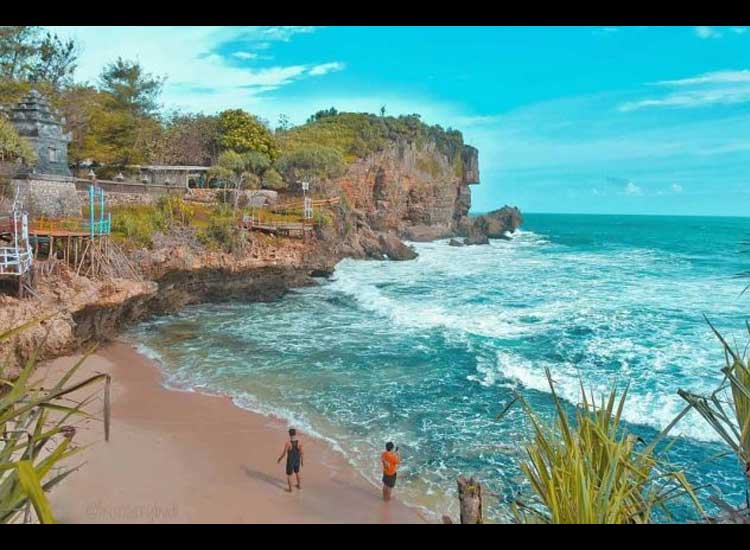NGOBARAN BEACH from Temple to Fried Sea Urchin – Coming to Ngrenehan Beach and enjoying grilled fish isn’t complete if you don’t stop at the beach next to it, Ngobaran. The location of this high cliff beach is only approximately two kilometers from Ngrenehan Beach. Not far, right? Ngrenehan Beach residents often talk about and stop by Ngobaran Beach, why not you?
Ngobaran is a quite exotic beach. When the water recedes, you can see a stretch of algae (seaweed) both green and brown. When viewed from above, the expanse of algae growing between the coral looks like rice fields in a densely populated area. Dozens of types of sea animals are also found among the coral, ranging from sea urchins, starfish, to shellfish.
But what other beaches don’t have is its cultural charm, from the buildings to the local food. One of the interesting things is that there are places of worship for four religions or beliefs standing close together. Is it a form of multiculturalism? Who knows.
The most clearly visible building is a place of worship such as a temple with white statues of gods. This place of worship was founded in 2003 to commemorate the presence of Brawijaya V, one of the descendants of the Majapahit king, in Ngobaran. The people who worship in this place are adherents of the Kejawan faith (not Kejawen, you know ). According to the story, the name “Kejawan” comes from the name of one of Brawijaya V’s sons, namely Bondhan Kejawan. The builder of this place of worship claimed to be a descendant of Brawijaya V and appointed one of the residents to look after this place.
Walking to the left of the place of worship, you will find a Joglo which is used as a place of worship for Kejawen followers. When YogYES visited this place, several Kejawen followers were praying. According to local residents, Kejawen beliefs are different from Kejawan. But they themselves are not really able to explain the difference.
If you continue along the path in front of Joglo, you will find a stone box covered with dry plants. The plant is fenced with gray wood. The point where this dry twig grows is said to be the place where Brawijaya V pretended to set himself on fire. He took this step because Brawijaya V did not want to fight against his own son, Raden Patah (King I of Demak).
The truth of the story about Brawijaya V is now widely doubted by many historians. The reason is, if Raden Patah attacks Brawijaya V, it will give the impression that Islam was spread through violence. Many historians believe that the existing historical evidence is not strong enough to state that Raden Patah carried out the attack. How to find out more, maybe you can find out for yourself.
A few meters from the box where the dry twigs grow, there is a temple for Hindu worship. It is not clear when the temple was founded.
In front of where the branches grow, there is a mosque measuring approximately 3×4 meters. The mosque building is quite simple because the floor is made of sand. As if integrated with the beach. Uniquely, if most mosques in Indonesia face west, this mosque faces south. The front of the place where the imam leads prayers is open so you can directly see the ocean. When YOGYES asked local residents, not many knew the reason. In fact, the local residents themselves were surprised because the person who built it was one of the famous Kyai followers of Nahdatul Ulama who lived in Panggang, Gunung Kidul. As a guide for those going to pray, local residents mark on the wall with red pencils the actual direction of the Qibla.
Once you are satisfied with being amazed by the worship site, you can walk down to the beach. If you come in the morning, visitors will find coastal communities harvesting seaweed to sell to middlemen. The results are good enough to meet their living needs.
However, if you come in the afternoon, you will usually find residents looking for sea urchins for food that evening. To be edible, the sea urchin’s spines are first crushed flat and then broken using a sickle. The flesh on the inside of the sea urchin is then pried off. Usually, people looking for porcupines are armed only with buckets, coconut filters, sickles and hats to avoid the heat.
The sea urchins obtained are usually seasoned with salt and chili and then fried. According to residents, sea urchin meat is quite chewy and delicious. Unfortunately, not many people sell this exotic food. But if you want to order, just try asking one of the residents to cook it. Who knows, you could also share ideas about how to cook sea urchins so that the residents of Ngobaran beach can use that knowledge to do business to improve their standard of living.
Link Rekomendasi :
- Prediksi Togel hk
- okewla
- Situs togel resmi
- Casino online
- Okewla
- Okewla
- Okewla
- Situs toto macau
- Bo togel
- Slot Thailand
- Slot Thailand
- Slot online gacor
- Casino online
- Togel casino
- Situs slot gacor
- Slot gacor
- Okewla
- Okewla
- Okewla
- Okewla
- Okewla
- Togel casino
- Bo togel
- Okewla
- Okewla
- Okewla
- Okewla
- Okewla
- Okewla
- Okewla
- Okewla
- Okewla
- Okewla
- Okewla
- Okewla
- Okewla
- Okewla
- Okewla
- Okewla
- Okewla
- Okewla
- Okewla
- Okewla
- Okewla
- Togel casino
- Togel casino
- Togel casino
- Scatter Pink
- Togel casino
